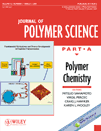Thermal behavior of poly(bisphenol A carbonate) in the presence of phosphorus compounds
Abstract
To clarify the interaction between poly(bisphenol A carbonate) (PBAC) and phosphorus compounds such as triphenylphosphine oxide (TPPO), triphenyl phosphate (TPP), and resorcinol bis(diphenyl phosphate) (RDP), PBAC was heated in the presence of these phosphorus compounds at 240 °C for 2 h, and the resulting polymers were analyzed by 1H NMR spectroscopy and gel permeation chromatography. When heated in the presence of TPPO, the PBAC sample decomposed extensively, resulting in a substantial decrease in molecular weight. On the other hand, thermal treatment in the presence of the phosphates increased the molecular weight. In both cases the molecular weight distribution became narrower. Thermal treatment of PBAC in the presence of both TPPO and TPP allowed us to control the molecular weight with a narrower distribution. © 2004 Wiley Periodicals, Inc. J Polym Sci Part A: Polym Chem 42: 1069–1074, 2004




